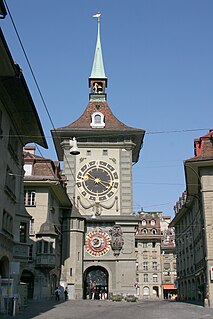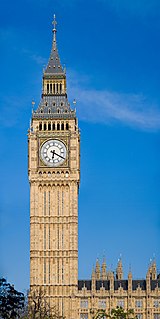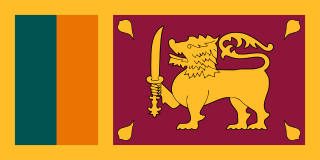
The Joseph Chamberlain Memorial Clock Tower, or simply Old Joe, is a clock tower and campanile located in Chancellor's court at the University of Birmingham, in the suburb of Edgbaston. It is the tallest free-standing clock tower in the world, although its actual height is the subject of some confusion. The university lists it as both 110 metres (361 ft) and 99 metres (325 ft) tall, whereas other sources state that it is 100 metres (328 ft) tall. In a lecture in 1945, Mr C. G. Burton, secretary of the University, stated that "the tower stands 329 ft [100 m] high, the clock dials measure 17 ft [5.2 m] in diameter, the length of the clock hands are 10 and 6 ft [3.0 and 1.8 m], and the bell weighs 5 long tons [5.1 tonnes]".

Clock towers are a specific type of building which houses a turret clock and has one or more clock faces on the upper exterior walls. Many clock towers are freestanding structures but they can also adjoin or be located on top of another building.

The Zytglogge is a landmark medieval tower in Bern, Switzerland. Built in the early 13th century, it has served the city as guard tower, prison, clock tower, centre of urban life and civic memorial.

Grimsby Dock Tower is a hydraulic accumulator tower and a maritime landmark at the entrance to the Royal Dock, Grimsby, in North East Lincolnshire, England. It was completed on 27 March 1852 with the purpose of containing a 30,000-imperial-gallon (140,000 L) reservoir at a height of 200 feet (61 m), that was used to provide hydraulic power to power the machinery of the Grimsby Docks. The extreme height of the tower was necessary to achieve sufficient pressure, and as a result of this, the tower can be seen for several miles around, even far inland on the north bank of the River Humber in villages such as Patrington.

The Abraj Al-Bait is a government-owned megatall complex of seven skyscraper hotels in Mecca, Saudi Arabia. These towers are a part of the King Abdulaziz Endowment Project that strives to modernize the city in catering to its pilgrims. The central hotel tower, the Makkah Royal Clock Tower, A Fairmont Hotel, has the world's largest clock face and is the third-tallest building and fifth-tallest freestanding structure in the world.
The Bandaranaike Airport attack was an assault by the Liberation Tigers of Tamil Eelam (LTTE) on Bandaranaike International Airport, on July 24, 2001. The attack was one of the boldest the LTTE mounted during its war with the Sri Lankan government, and had a profound impact on the country's military, economy, and airline industry.

Big Ben is the nickname for the Great Bell of the clock at the north end of the Palace of Westminster in London and is usually extended to refer to both the clock and the clock tower. The official name of the tower in which Big Ben is located was originally the Clock Tower, but it was renamed Elizabeth Tower in 2012 to mark the Diamond Jubilee of Elizabeth II.

St. Peter is one of the four main churches of the old town of Zürich, Switzerland, besides Grossmünster, Fraumünster and Predigerkirche.

Old Colombo Lighthouse or Colombo Fort Clock Tower is a clock tower and was a lighthouse in Colombo. The lighthouse is no longer operational, but the tower remains and functions as a clock tower. It is located at the junction of Chatham Street and Janadhipathi Mawatha in Colombo fort.

The 2008 Piliyandala bombing was a bombing of a commuter bus carried out on April 25, 2008 in Piliyandala, Sri Lanka, a suburb of Colombo. The bombing killed 26 and injured at least 64, and was the first major attack against civilians on the island since the April 6 Weliveriya bombing that killed Highways Minister Jeyaraj Fernandopulle and national athletics coach Lakshman de Alwis. It was also the deadliest bus bombing since the January 16 attack on a civilian bus at Buttala.

Batadombalena is an archaeological site with evidence of habitation from 8,000 years BCE, Balangoda Man, located 85 km (52.8 mi) from Colombo in Sri Lanka, a two-hour drive from Colombo.

The Kelani Valley railway line in Sri Lanka, covering the breadth of Colombo District. The line is owned, maintained, and operated by Sri Lanka Railways.

The Puttalam Lagoon is a large 327 km2 (126 sq mi) lagoon in the Puttalam District, western Sri Lanka.

The Kremlin Clock or Kremlin Chimes, also known colloquially in the West as Moscow Clock Tower, is a historic clock on the Spasskaya Tower of Moscow Kremlin. The clock dial is above the main gates to Red Square. For decades, the chimes have rung on the quarter-hour, with bells tolling for each full hour.

The Upper Kotmale Dam is located in Talawakele, within the Nuwara Eliya District, in the Central Province of Sri Lanka. The dam feeds the third largest hydroelectric power station in the country.

Sri Lanka participated at the 2012 Summer Olympics in London, which was held from 27 July to 12 August 2012. The country's participation at London marked its sixteenth appearance in the Summer Olympics since its debut at the 1948 Summer Olympics, having missed only the 1976 Games. The delegation consisted of seven competitors: two athletics competitors, two badminton players one shooter and two short-distance swimmers. Cooray, Samarakoon and Karunaratne qualified for the Games by meeting their respective qualifying standards; the remainder of the team entered through wildcard or quota places. Karunarante was the flag bearer for the opening and closing ceremonies.

Locomotives and trainsets of Sri Lanka Railways consist mostly of diesel locomotives and multiple units. Steam locomotives are no longer used, except on heritage trains, such as the Viceroy Special.
The Pollupalai and Vallimunai Wind Farms are two wind farms built together by Joule Power and Beta Power, on the north-eastern shore of the Jaffna Lagoon, in Pachchilaipalli, Sri Lanka. Both wind farms are owned by the parent company Windforce, and have an installed capacity of 12 megawatts each, and an annual production of approximately 60 GWh. The wind farms are the first-ever to be constructed in the Northern Province of Sri Lanka.

















